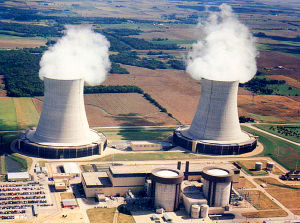Nuclear power to save the world from ecological disaster
The closing of all nuclear stations in the world would result in additional emission of 600 million tons of carbonic acid in the atmosphere a year
Peaceful atom has been brought into fashion again. Scientists have recently marked the 50th anniversary of using atoms in peaceful purposes: the commercial use of scientific developments in the field of atom splitting started a 50 years ago. Experts of the International Atomic Energy Agency (IAEA) said in their report that nuclear reactors currently produce about one-sixth of all electric power generated on the globe. 
There are about 400 nuclear reactors in the world today, situated in over 30 countries. Twenty-four reactors installed on ten nuclear power plants operate in Russia. A lot of people perceive nuclear power as something exotic or dangerous. However, there are states, in which the use of atomic energy has become the central and vital source of electric power. China's share of nuclear power makes up only 2.3 percent of the country's electricity, whereas the situation is absolutely different in the USA, Russia and France: 20, 16 and 78 percent respectively.
The history of peaceful atom has had its ups and downs. The Chernobyl disaster of 1986 became the most tragic page at this point. The explosion of the nuclear reactor of the Chernobyl nuclear power plant made a lot of countries shut down their projects in the field of atomic energy. Ecological activists still impede the development of the industry in the majority of EU states. Furthermore, they make would-be members of the European Union close their nuclear enterprises: it has already happened so with Lithuania and Bulgaria.
Nevertheless, the attitude to the peaceful atom has been changing in the world lately. The nuclear industry has become less dangerous with the help of the technological progress. In addition, the nuclear production is more ecologically friendly in comparison with the traditional heating production, which involves the burning of organic fuel (oil, gas, coal) and the emission of harmful gases in the atmosphere.
IAEA experts said that the closing of all nuclear stations in the world would result in additional emission of 600 million tons of carbonic acid in the atmosphere every year. It is noteworthy that the international right has taken the side of the nuclear industry too. The now-effective Kyoto Protocol virtually restricts the burning of hydrocarbon fuel. The most important argument in defense of the nuclear power is purely economical. Needless to say that a lot of countries cannot afford spending up to a billion dollars to build a nuclear power plant. The exploitation of nuclear reactors, however, turns out to be much more profitable than burning gas and black oil at thermoelectric power stations. The difference becomes more and more considerable as oil prices continue growing in the world. If the price on nuclear fuel doubles, the cost of the nuclear electricity will gain only 2-4 percent. If natural gas or oil prices rise, the price of the thermal electricity will eventually become 70 percent as expensive.
One should also bear in mind the fact that planet Earth is running out of its oil reserves. Specialists do not know when current oil fields become exhausted. However, such a perspective implies the continuing rise in oil prices all over the world. The situation with natural gas is a lot better so far: the reserves are high, prices are stable. On the other hand, it is about time scientists should look for a cheaper and more ecological alternative too.
It is worth mentioning that up to 90 percent of global uranium extraction falls on only seven countries of the world. Canada and Australia enjoy the largest developments of uranium, with Kazakhstan, Niger and Russia following. In spite of the 5th position on the list, Russia is the world leader on the export of nuclear fuel (40% on the world market). However, experts believe that Russia will suffer from the lack of fuel in about 20 years if the speed of uranium extraction is preserved (it goes about the depletion of developed uranium reserves).
In addition, people can do without any fuel at all. The so-called alternative energy uses the power of wind, the sun, rivers and tides, including the hydrogenous technology. This field of power engineering is at a very early stage of its development to make a real competition for hydrocarbons and atoms. However, governments in many countries of the world, not to mention ecological movements, stand up for the development of the no-fuel power industry. On the whole, specialists believe that no energy will be able to take the decisive advantage: hydrocarbon fuels will give way to nuclear and renewable sources of energy.
IAEA experts are certain that the peaceful atom share in the world output of electric power will be growing: it is supposed to make up not less than 25 percent by 2030. Russian and Western nuclear enterprises are currently launching the fight for China. The Chinese government has recently announced an intention to build 40 power-generating units within 15 years. A sudden increase of the number of nuclear reactors does not add more safety to the word. On the other hand, it is inevitable.
The future of the nuclear power is quite prosperous indeed. One should not brush negative aspects aside, though. Just one nuclear power plant was enough to wipe a whole city off the geographical map – Chernobyl. The utilization of spent nuclear fuel poses a very important problem too.
Subscribe to Pravda.Ru Telegram channel, Facebook, RSS!




